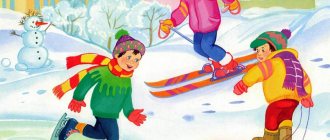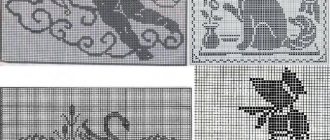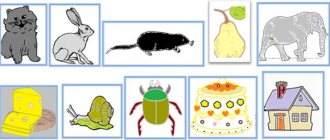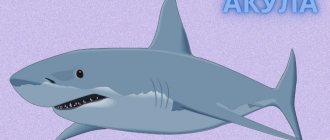Let's play with cubes
There are so many construction sets you can find on store shelves now! Some consist of tubes, others of geometric shapes with slots, and the components of others resemble pieces of a jigsaw puzzle. Construction sets with magnets, Velcro, Lego-compatible construction sets and “ego”. Many construction kits come with detailed assembly diagrams for a particular model.
But still, ordinary wooden cubes and “Builder” sets, in which, in addition to cubes, there are bricks, cylinders, prisms and other parts, continue to enjoy unfading popularity. Our grandparents, fathers and mothers played with cubes. Our children enjoy playing with blocks.
The cubes are different. Wooden ones - with sharp corners, large plastic ones with smoothed corners (especially for the little ones). There are cardboard and foam cubes (covered with fabric or washable vinyl material).
At different ages, cubes are used in different ways. A one-year-old baby, diligently puffing, builds a tower of two cubes. A three-year-old girl is building a baby bed out of blocks. And a seven-year-old boy builds a huge palace of the snow queen or a crusader fortress.
When should you start playing with blocks with your child? Does the child need adult help when playing with them? Should children be taught how to build with blocks? Can dice play become a learning game?
Let's try to understand these issues.
Age 1.5–3 years
Getting to know the figures
Show and name to your child all the geometric bodies that are in your construction set. These can be: cubes, bricks, cylinders, triangular prisms, arches, blocks, cones, and other shapes. Sometimes you come across sets with wooden balls; if you don’t have one, add a couple of small rubber balls to your games with building materials.
Ask your child to arrange the figures into piles according to shape or distribute certain figures to different toys (bear - cubes, bunny - bricks, and so on). Place several figures in a small bag and ask your baby, without looking, to take out the figure that you will name or show.
When playing with your baby, be sure to name the colors of the parts. You can play a game with arranging the shapes in your houses (you can cut out silhouettes of houses from colored paper or make them from shoe boxes, painting them in the desired colors, but this option is more labor-intensive). If there are identical geometric bodies of different sizes, consider where they are large and where they are small. Make houses of different sizes (paper silhouettes of the same color (neutral) or boxes of two or more sizes, as needed).
Try rolling different parts of the “Builder” down the slide. Any board placed on a large cube or stack of books can serve as a hill. Cubes and bricks, prisms slowly slide down the slide, balls and cylinders (if placed on their side) quickly roll down. Draw the child's attention to how the speed of movement of the figures rolling down the slide changes, and the distance they will travel if you change the angle of its inclination in one direction or another. Or if you put the same part at the top of the slide, then in the middle, then at the very edge - at the bottom.
We are building
Show your child how to build towers. Let him try it himself. Consider with him which figures can be placed on top of each other and which cannot (for example, balls, cylinders sideways, triangular prisms if placed on a base).
The baby cannot yet build real large structures, but with great pleasure he will make a primitive house for a baby doll or a soldier (two bricks standing at the end, one lying across the top). Girls willingly make cribs, armchairs, benches for dolls and nesting dolls. Boys build garages for small cars.
To make your child want to build large structures, build them yourself in front of his eyes. Involve your child in joint construction - let him give you the right part on time or put any in the place he liked. Don't be angry with your child if he violates your plan.
Try not to build similar projects, come up with something new and unusual every time. Do not strive for symmetry in your buildings; on the contrary, make castles, houses, and palaces that are unlike anything else.
After the game, the cubes must be removed so that they do not lie under your feet. Make a piggy bank box for your baby with slots that match the parts of the set. Let him put the cubes into the box on his own after each game (at first, of course, you can help him a little). Or put them in a regular box.
Age 3–5 years
Getting to know the figures
From the age of three, children begin to be taught not only to distinguish, but also to correctly name the main parts of construction sets.
Tell your child what the parts of the shapes are called - face, corner, edge
. Ask to see these parts of different figures.
Most likely, the child is already well acquainted with the concepts of big and small. It's time to add the following concepts to the dictionary: high - low, wide - narrow, long - short, describing individual parts or entire buildings. Ask to build a short or long path, low or high fences and turrets, wide or narrow gates, paths, and so on.
"Monkey"
Play “Monkey” with your child (the game is described in the Nikitins’ book “Intellectual Games”). To begin with, take two parts (two cubes, a cube or brick, two bricks). Give the parts exactly the same in shape, color and size to your baby. Agree with him that he is a monkey, and monkeys love to repeat everything after everyone else. You will build, and the monkey will repeat after you.
Build the simplest model - a turret, a path, a fence. Wait until the child copies it, then collect the next one. You shouldn’t play for too long; stop as soon as you notice that the child is tired or bored. Then he will be happy to play with you next time. Do not complete the task for your child if he cannot copy your model on his own. Better offer another, simpler option.
Gradually move on to copying buildings of three to five or more parts. While playing, ask your child to think about what this or that building looks like.
Remaking
The next most difficult task is converting samples. An adult builds a small structure and asks the child to build the same model, changing some parameters. The simplest thing is to change the color. Your tower is entirely red, and let the children's tower be made of the same parts, but blue. Then let him change the size. Instead of small parts, let him take large ones (or vice versa). Then change the shape: instead of cubes - bricks (but the number of parts, their color and location are preserved) and so on.
We build according to the description
Invite your child to build two houses on their own - for a large and a small doll (or garages for different cars). Let him select the details and think through the design so that the characters (objects) fit into the house (garage).
Sequences
Teach your child to continue a series in which certain shapes are repeated sequentially. Lay out the beginning of the path (fence), for example, cube - brick - cube - brick or cubes: red - blue - red - blue. Ask your child to guess which piece will be next. Gradually make the tasks more difficult by alternating three different parts. Or a part of one type, followed by two parts of another type, and so on. Pay the child’s attention not only to the sequence of figures, but also to their location: a brick can lie flat, and the baby will place it on its edge; your arch has the recess (collar) down, and his has it up.
Building a city
Draw a path on a sheet of paper, and along it on both sides the contours of the faces of geometric bodies (place cubes, bricks, cylinders directly on the sheet and circle). This will be a project for a new city. Let the child arrange the houses according to the design and play in the new city - drive cars, place dolls and small animals.
Mirror
Place two or three figures on the table in a row (or one under the other - a turret). Ask your child to place the same figures next to each other in reverse order. Over time, increase the number of elements in the game.
Let's remember
Make a path or tower on the table from several parts (start with three or four elements, when the child gets the hang of it, increase the number). Ask him to look at the path (tower) and turn away. Change the location of one figure (then two or three). Ask your child to restore the original arrangement of the figures.
Make a path (tower) of shapes, let your child look at it, and then remove it. Invite your child to restore the structure himself.
Ask your child what a particular part looks like. Ask to find objects in the room that are similar to her. Ask him to remember that he has seen the same form before.
Age 5–7 years
We build according to instructions
Children of older preschool age like to play with blocks on their own for a long time (of course, if they do not sit all day long with “Dandy” in their hands, which caring parents, of course, will not allow).
But sometimes you can give your child an order to build certain structures. For example, build a house with a certain number of floors and apartments. Or a garage for two small and one large car. Children who love fairy tales can be offered to build a house for the seven dwarves (small, but with seven apartments) or a house for Carlson (naturally, on the roof of an apartment building).
We build masterpieces of world architecture
If you introduce your child to the history of world art and architecture (using reproductions and photographs) or the famous buildings of your city, you can invite him to try to depict this or that architectural monument with cubes. The easiest of all the famous structures to reproduce using a building set is, of course, Stonehenge. But I think that children will respond with no less inspiration to the proposal to build something like the Cheops pyramid or the Kremlin wall.
Game "Drawing"
To play you will need cubes, bricks, and a set of geometric shapes. They can be cut from colored cardboard of the same color.
Cardboard rectangles of the same color (six pieces of each size):
• 2.5 x 5 cm;
• 2.5 x 10 cm;
• 5 x 10 cm.
Cardboard squares of the same color (ten pieces):
• 5 x 5 cm.
Ask your child to name you all the shapes (from cardboard). Tell us about their parts. What are angle and side? Offer to show equal sides of one figure, two different figures.
Show and name to your child the parts of these geometric bodies (cubes and bricks) - edge, angle, side.
Compare geometric solids with rectangles and squares. Draw your child's attention to the fact that each face of the cube is a square, and the brick has a pair of different rectangular faces. Have your child compare the rectangles to the sides of the brick and find the representation of the front, side, and top faces.
Invite your child to build a simple house from three to six elements. Draw a plan for its construction on the table using geometric shapes (front view). Then switch roles - you build, the child makes the plan.
Then do the same, depicting the building from the side (on the left).
Then the same thing, but from above.
Gradually come to the point of depicting all three types of buildings at the same time (as in the real drawing).
Playing with constructors
The very first construction set can be given to a child who is a year and a half old. The parts of the designer should be large and connect to each other easily, without effort.
Show your child how to connect the pieces. Build several houses, cars or other simple models before his eyes so that the child can see the possibilities of this game.
Try to use construction sets as educational games. Name the colors of the figures, compare the sizes of the buildings. Encourage your child to complete tasks described in games with building blocks.
You should not buy many construction sets with different parts and principles of their connection. It is enough to buy one or two types of construction sets. If there are not enough parts, it is better to buy another set of the same type.
Storytelling Cubes
The rules of the board game Story Cubes, very briefly, can be described as follows: roll the dice and tell a story based on the pictures you get. In the original game there are 9 dice to play with.
Game Rory's Story Cubes "Story Cubes: Journeys"
To date, Rory's Story Cubes has released many themed story cubes and additional sets of 3 cubes. Thus, you can simultaneously play with 12 cubes on topics: astronomy, the primitive world, first aid, heroes, myths, mysticism, fairy tales, dinosaurs, fantasies, travel, etc.
All you need to do is take a few cubes and throw them on the table - voila, you already have the starting points from which the plot of your unique fairy tale will develop.
Take the dropped die and start fantasizing about how the dropped object or character appeared in your story, what it will do and how it will influence the overall course of the plot.
Then take the next cube and weave it into the fabric of your story, and then another, and another, continuing the story and adding more and more details to it.
You can use any cubes, any combinations and sequences - you are a storyteller and everything is in your will.
You can compare prices for the original versions of the game and analogues with Aliexpress.
For children we offer a simplified version.
Download and print story cubes
A free version of the Story Cubes board game can be downloaded and printed below. This is an analogue of the game Rory's Story Cubes for children.
There are 4 cubes , each of which will tell the plot for the story: who? Where? What? When?
Thus, at the same time there are 4 cubes in the game with 24 pictures with objects, time, place and event . Such a game will stimulate the child’s imagination, teach him to compose and tell stories, construct phrases, and develop logic, thinking, and rhetoric.
Who : 4 dice: characters, animals, objects and group of characters.
Where : dacha, house; island, beach; lock; forest; mountain; city.
What to do : eat, run, hide, talk, quarrel, cook.
When : evening, night, morning, day.
Before downloading, click on the image to enlarge.
Story Cubes with Ludo
These are themed story cubes featuring the popular French character Ludo. Only 7 cubes.
You probably don't know him, but it won't hurt the game.
Fairytale Kingdom!
This set also comes with a blank cube - get creative and draw what you think is missing from your set!
Magic Kingdom
Now the magic cubes. After all, a fairy tale is an ideal space for developing children’s imagination, right?
These cubes are good to print on colored paper, because their images are just outlines.





